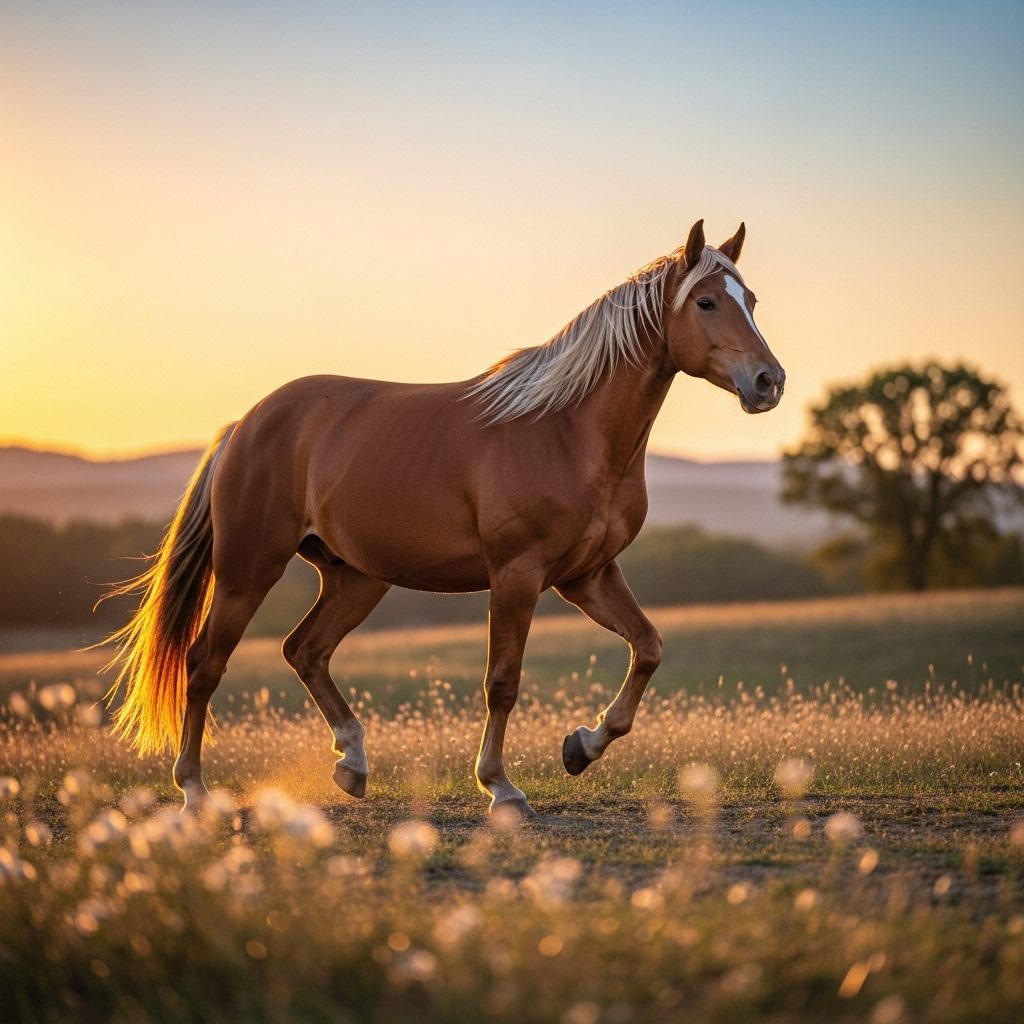Missouri Fox Trotter Horse Breed: 3 Gaits That Define Comfort
Effortless motion and a calm disposition ensure riders stay comfortable on any terrain.

Missouri Fox Trotter Horse Breed Profile
The Missouri Fox Trotter is an American horse breed celebrated for its gentle temperament, comfort-enhancing gait, and adaptability both on rugged terrain and in show arenas. Developed in the Ozarks in the early 19th century, these horses are revered today as reliable trail companions, versatile ranch workers, and stylish performers. This profile explores their history, unique gaits, physical traits, care requirements, and suitability for various disciplines.
Breed Overview
| Breed Name | Missouri Fox Trotter |
|---|---|
| Country of Origin | United States (Missouri, Ozark Mountains) |
| Height | 14–16 hands (56–64 inches) standard; 11–14 hands for ponies |
| Weight | 900–1,200 lbs (410–540 kg) |
| Primary Use | Trail riding, ranch work, competitions, pleasure riding |
| Distinguishing Features | “Fox trot” gait, muscular build, stock horse body, gentle temperament |
Quick Facts
- Registry Established: 1948 by the Missouri Fox Trotting Horse Breed Association (MFTHBA)
- Main Gaits: Flat-footed walk, fox trot, rocking-chair canter
- Estimated Number Registered: Nearly 100,000
- Color: All solid colors or pinto patterns; common white markings on face and legs
History of the Missouri Fox Trotter
The breed emerged in the Ozark Mountains of Missouri in the early 1800s, as settlers from neighboring states sought horses that combined stamina, comfort, surefootedness, and versatility. Bloodlines trace back to Kentucky, Tennessee, Illinois, and Arkansas, with early stock required to plow fields, haul timber, herd cattle, and serve as premiership buggy and riding horses.
The Fox Trotter was bred for its signature “fox trot,” a smooth four-beat diagonal gait ideal for traversing uneven terrain. Its utility quickly made it a favorite of ranchers, hunters, forest rangers, and families throughout the region.
- 1948: Missouri Fox Trotting Horse Breed Association (MFTHBA) founded.
- 1992: European registry established.
- 2006: Historic type registry formed in the U.S. to preserve the original bloodlines.
Physical Characteristics
Missouri Fox Trotters are recognized for their mid-sized, muscular, yet agile build. Their conformation suits both stamina and comfort:
- Head: Straight facial profile, expressive eyes, alert expression
- Neck: Medium length, pronounced withers
- Body: Short back, well-muscled frame, sturdy legs
- Height: Standard registry 14–16 hands (56–64 inches); pony registry 11–14 hands
- Weight: 900–1,200 lbs
- Color: Can be any solid color or pinto; white facial and leg markings frequent
Fox Trotters exude a proud, elegant presence, often carrying their heads and tails high—with movement characterized by grace and athleticism.
Distinctive Gaits
Gaited horses are those with unique, often naturally inherited, intermediate gaits beyond the basic walk, trot, and canter. Missouri Fox Trotters have three signature gaits:
- Flat-Footed Walk: A smooth, four-beat walk where each hoof lands individually, combining glide and rhythm for rider comfort. The hind foot reaches forward, minimizing bounce and fatigue.
- Fox Trot: The breed’s hallmark gait is a four-beat broken diagonal that looks like a walking horse in front and a trotting horse in back. The front hoof of the diagonal pair lands just before the opposite rear hoof, ensuring at least one hoof maintains contact for stability. Riders experience little vertical movement, making this gait exceptionally smooth—even over rough terrain.
- Rocking-Chair Canter: A gentle, three-beat lope with a rolling “rocking horse” motion, suitable for athletic performance or relaxed riding in arena or open field.
| Gait | Description | Speed | Comfort |
|---|---|---|---|
| Flat-Footed Walk | Four-beat, deliberate steps | 3–5 mph | High |
| Fox Trot | Four-beat broken diagonal; front foot precedes opposite rear | Up to 10 mph | Exceptional |
| Rocking-Chair Canter | Three-beat, rolling, “rocking horse” movement | 7–12 mph | High |
The breed does not require special shoeing or extensive training to demonstrate these gaits—they are an inherited trait, though show and competition may refine the natural movements.
Personality and Temperament
The Missouri Fox Trotter shines with its gentle nature and relaxed, friendly temperament. Well-suited for riders of all ages and skill levels, including children and beginners, these horses are:
- Willing: Eager to work, learn, and cooperate
- Affectionate: Enjoy human company and handling
- Calm: Tolerant of energetic young riders, unflappable on trails
- Intelligent: Quick learners, responsive to consistent training
- Brave and Reliable: Excellent in varied terrain, surefooted and dependable
These characteristics, paired with comfort-focused gaits, make Fox Trotters an ideal choice for pleasure riding, therapeutic programs, and working ranch environments.
Uses and Suitability
While the breed was once a mainstay for Ozark settlers handling varied chores, today 90% of Missouri Fox Trotters are used primarily for trail riding, endurance, and pleasure mounts. Their stamina and agility make them popular for:
- Trail Riding: Celebrated for ease of movement and comfort over long distances
- Endurance Riding: Stamina and smooth gaits suit them for competitive distances
- Ranch Work: Versatility in cattle-herding, plowing, and all-around labor
- Competition: Excelling in model (conformation), performance (under saddle), and versatility classes such as Western pleasure, English, horsemanship, reining, pole bending, and barrel racing
- Therapeutic Riding: Gentleness and comfort make them suitable for therapeutic and adaptive riding programs
- Show Horse: Displayed for beauty, style, and unique gait in the ring
Fox Trotters are also known for their roles in film and television, prized for reliability and gentle disposition on set.
Care and Management
With few breed-specific health concerns, Fox Trotters generally require standard horse care to remain healthy and active:
- Feeding: Provide balanced diet of forage (grass and/or hay), supplemented by quality grain as needed. Ensure access to clean, fresh water at all times.
- Grooming: Regular brushing helps maintain coat condition; check hooves daily, trim/shoe as appropriate for terrain and activity.
- Veterinary Care: Annual vaccinations, dental checks, routine deworming, and monitoring for lameness or gait irregularity.
- Housing: Safe pasture or paddock with shelter from wind and extreme weather.
- Exercise: Allow for regular, varied activity—trail rides, arena work, or ground exercises keep mind and body fit.
- Hoof Care: Pay attention to the breed’s characteristic gait, ensuring hooves remain balanced for even wear and optimal movement.
Fox Trotters are generally hardy and have good hooves, making them ideally suited for trail and ranch work over rocky or steep landscapes. Good nutrition and attentive maintenance help preserve their longevity and comfort.
Purchasing, Registration, and Associations
If considering ownership, keep in mind:
- Missouri Fox Trotting Horse Breed Association (MFTHBA) is the main registry.
- Ponies under 14 hands can be registered in a separate category.
- Bloodlines are key for show and breeding prospects.
- Prices vary depending on pedigree, training, age, and competition record.
Common Health Matters
- No breed-specific genetic disorders are widely reported, though standard equine conditions such as laminitis, colic, and respiratory infections may occur.
- Monitor gait for abnormalities; periodic professional evaluation helps maintain optimal movement.
- Older horses may benefit from joint supplements due to working long distances.
Frequently Asked Questions (FAQs)
Q: What makes the Missouri Fox Trotter unique?
A: Its smooth “fox trot” diagonal gait, gentle temperament, and versatility across disciplines. No special training is required to achieve the signature comfortable movement.
Q: Are Fox Trotters suitable for beginners or children?
A: Yes; their calm and trustworthy personalities, combined with easy-to-sit gaits, make them ideal for inexperienced riders and therapeutic programs.
Q: What disciplines can Missouri Fox Trotters compete in?
A: Western and English riding, ranch riding, trail and endurance events, reining, barrel racing, model, and versatility classes—plus any activity where comfort and reliability are prized.
Q: How do I care for a Missouri Fox Trotter’s special gait?
A: No special care is needed; regular hoof trims and attentive farriery ensure natural gaits remain smooth and comfortable. Quality feed, water, and exercise are essential.
Q: What is the average lifespan of a Missouri Fox Trotter?
A: With proper care and management, they typically live 25–30 years, often staying rideable into advanced age.
Is the Missouri Fox Trotter Right for You?
Choosing a Missouri Fox Trotter means investing in a horse that’s equally at home in the show ring, working pasture, and on scenic trails. If you’re seeking:
- Comfort on long rides
- Gentle, responsive personality
- Versatility for a range of equestrian activities
- Low-maintenance care requirements
then the Missouri Fox Trotter may be the ideal breed for your needs.
Related Breeds
- Tennessee Walking Horse: Known for “running walk” gait, prized for smoothness.
- American Saddlebred: Versatile show and pleasure horse, known for high-stepping action.
- Rocky Mountain Horse: Renowned mountain gaited breed.
Final Thoughts
The Missouri Fox Trotter stands as a testament to American resourcefulness and equine innovation. Its distinctive gait, reliable temperament, adaptability, and easy care have solidified its place as one of the country’s most beloved horse breeds—perfect for enthusiasts of all backgrounds, from competitive riders to casual trail explorers.
References
- https://www.horseillustrated.com/horse-breed-missouri-fox-trotter
- https://www.holistapet.com/blogs/horse-breeds/missouri-fox-trotter
- https://www.hiddentrails.com/general/breeds/missouri_fox_trotting_horse.htm
- https://madbarn.com/missouri-fox-trotter-breed-profile/
- https://en.wikipedia.org/wiki/Missouri_Fox_Trotter
Read full bio of Srija Burman












